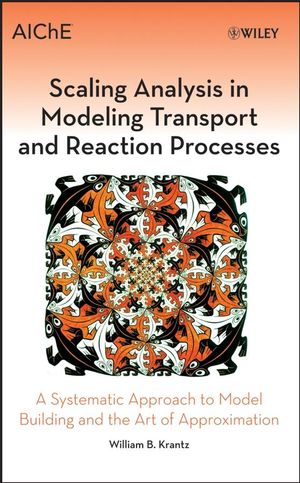Scaling Analysis in Modeling Transport and Reaction Processes: A Systematic Approach to Model Building and the Art of ApproximationISBN: 978-0-471-77261-3
Hardcover
544 pages
June 2007
 This is a Print-on-Demand title. It will be printed specifically to fill your order. Please allow an additional 15-20 days delivery time. The book is not returnable.
|
||||||
1. Introduction.
1.1 Motivation for Using Scaling Analysis.
1.2 Organization of this Book.
2. Systematic Method for Scaling Analysis.
2.1 Introduction.
2.2 Mathematical Basis for Scaling Analysis.
2.3 Order-of-One Scaling Analysis.
2.4 The Scaling Alternative for Dimensional Analysis.
2.5 Summary.
3. Applications in Fluid Dynamics.
3.1 Introduction.
3.2 Fully Developed Laminar Flow.
3.3 Creeping and Lubrication-Flow Approximations.
3.4 Boundary-Layer Flow Approximation.
3.5 Quasi-Steady-State Flow Approximation.
3.6 Flows with End and Sidewall Effects.
3.7 Free Surface Flow.
3.8 Porous Media Flow.
3.9 Compressible Fluid Flow.
3.10 Dimensional Analysis Correlation for the Terminal Velocity of a Sphere.
3.11 Summary.
3.E Example Problems.
3.E.1 Gravity-Driven Laminar Film Flow down a Vertical Wall.
3.E.2 Flow between Two Approaching Parallel Circular Flat Plates.
3.E.3 Design of a Hydraulic Ram.
3.E.4 Rotating Disk Flow.
3.E.5 Entry Region Flow between Parallel Plates.
3.E.6 Rotating Flow in an Annulus with End Effects.
3.E.7 Impulsively Initiated Pressure-Driven Laminar Tube Flow.
3.E.8 Laminar Cylindrical Jet Flow.
3.E.9 Gravity-Driven Film Flow over Saturated Porous Media.
3.E.10 Flow in a Hollow Fiber Membrane with Permeation.
3.E.11 Falling Head Method for Determining Soil Permeability.
3.P Practice Problems.
3.P.1 Alternate Scales for Laminar Flow between Stationary and Moving Parallel Plates.
3.P.2 Laminar Flow between Stationary and Moving Parallel Plates.
3.P.3 Gravity- and Pressure-Driven Laminar Flow in a Vertical Tube.
3.P.4 Axial Flow in a Rotating Tube.
3.P.5 Laminar Flow between Converging Flat Plates.
3.P.6 Laminar Flow between Diverging Flat Plates.
3.P.7 Laminar Flow in a Diverging Nozzle.
3.P.8 Steady-State Flow between Parallel Circular Disks.
3.P.9 Unsteady-State Flow between Parallel Circular Disks .
3.P.10 Steady-State Flow between Spinning Parallel Circular Disks.
3.P.11 Lubrication-Flow Approximation for a Hydraulic Ram.
3.P.12 Flow in a Rotating Disk Viscometer.
3.P.13 Flow in an Oscillating Disk Viscometer.
3.P.14 Falling Needle Viscometer.
3.P.15 Leading Edge Considerations for Laminar Boundary-Layer Flow.
3.P.16 Laminar Boundary-Layer Flow with Blowing.
3.P.17 Laminar Boundary-Layer Flow with Suction.
3.P.18 Entry Region Laminar Flow in a Cylindrical Tube.
3.P.19 Pressure-Driven Flow in an Oscillating Tube.
3.P.20 Countercurrent Liquid-Gas Flow in a Cylindrical Tube.
3.P.21 Stratified Flow of Two Immiscible Liquid Layers.
3.P.22 Laminar Cylindrical Jet Flow.
3.P.23 Free Surface Flow down a Plane with Condensation.
3.P.24 Free Surface Flow over a Horizontal Filter.
3.P.25 Curtain-Coating Flow.
3.P.26 Flow in a Semi-Infinite Porous Media Bounded by a Flat Plate.
3.P.27 Porous Media Flow between Parallel Flat Plates.
3.P.28 Gravity-Driven Film Flow over a Saturated Porous Media.
3.P.29 Radial Flow from a Porous Cylindrical Tube.
3.P.30 Entry-Region Flow in a Tube with a Porous Annulus .
3.P.31 Steady-State Laminar Flow of a Compressible Gas..
3.P.32 Velocity Profile Distortion Effects Owing to Fluid Injection and Withdrawal .
3.P.33 Flow between Parallel Impermeable and Permeable Flat Plates.
3.P.34 Flow in an Annulus with Fluid Injection and Withdrawal.
3.P.35 Flow in a Closed-End Permeable Hollow Fiber Membrane.
3.P.36 Dimensional Analysis for Flow around a Falling Sphere.
3.P.37 Dimensional Analysis for Impulsively Initiated Laminar Tube Flow.
3.P.38 Dimensional Analysis for Flow in an Oscillating Tube.
3.P.39 Dimensional Analysis for Curtain-Coating Flow.
3.P.40 Dimensional Analysis for Flow between Parallel Membranes.
3.P.41 Dimensional Analysis for Flow in a Hollow Fiber Membrane.
4. Applications in Heat Transfer.
4.1 Introduction.
4.2 Steady-State Heat Transfer with End Effects.
4.3 Film Theory and Penetration Theory Approximations.
4.4 Small Biot Number Approximation.
4.5 Small Peclet number approximation.
4.6 Boundary-Layer or Large Peclet Number Approximation.
4.7 Heat Transfer with Phase Change.
4.8 Temperature-Dependent Physical Properties.
4.9 Thermally Driven Free Convection - the Boussinesq Approximation.
4.10 Dimensional Analysis Correlation for Cooking a Turkey Taylor



